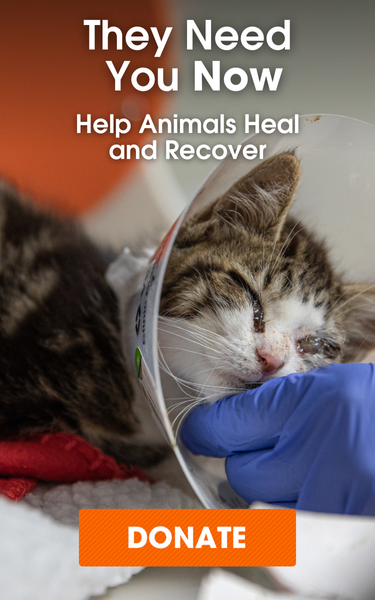
Cat Grooming Tips
This page contains links that lead to aspca.org/chewy. If you purchase any items through the affiliate links on that page, the ASPCA may receive a commission of 8% of your purchase at no additional cost to you. Thank you for your support!
A clean cat is a happy cat, and we're here to help! From nail trims to bathing, a little maintenance goes a long way. Read on to find out how to keep your kitty’s eyes, ears, teeth, skin and fur healthy and clean. Please note: There are some cats who do not tolerate being groomed. If your cat fights the grooming process, and there is some potential that injury could occur to your cat or yourself, please make an appointment with a professional groomer or a veterinarian to have your cat groomed.
Skin and Fur Care
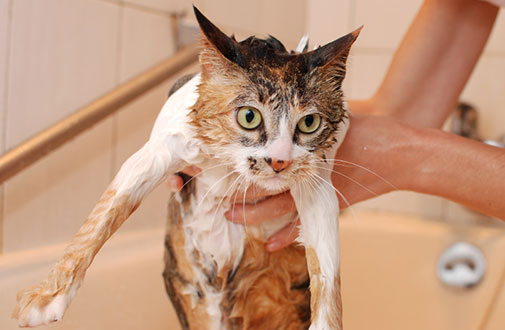
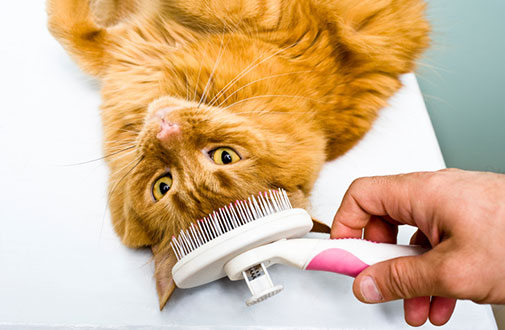
Bathing Your Cat
With her built-in grooming tools (tongue and teeth), your fastidious feline is well-equipped to tackle her own hair care needs. But if she is very dirty or gets into something sticky or smelly, you may need to give her a bath. Follow these steps to ensure minimal stress and maximum efficiency.
Expand to read more
- Schedule baths when your cat is at her most mellow. A play session with a cat dancer or other toy of choice can help tire out even the friskiest of felines.f
- For your own protection, we recommend trimming Fluffy’s claws before bathing.
- Give your cat a good brushing to remove any loose hair and mats.
- Gently place some cotton in her ears to keep the water out.
- Place a rubber bath mat in the sink or tub where you’ll be bathing your kitty so she doesn’t slip. Fill with three to four inches of lukewarm (not hot, please!) water.
- Use a hand-held spray hose to thoroughly wet your pet, taking care not to spray directly in her ears, eyes and nose. If you don’t have a spray hose, a plastic pitcher or unbreakable cup works great.
- Gently massage your pet with a solution of one part cat shampoo (human shampoo can dry out her skin) to five parts water, working from head to tail, in the direction of hair growth. Take care to avoid the face, ears and eyes.
- Thoroughly rinse the shampoo off your cat with a spray hose or pitcher; again, be sure the water is lukewarm. Take good care that all residue has been removed, as it can irritate the skin and act as a magnet for dirt.
- Use a washcloth to carefully wipe your pet’s face. Plain water is fine unless her face is very dirty—in which case, we recommend using an extra-diluted solution of shampoo, being very cautious around her ears and eyes.
- Wrap your cat in a large towel and dry her with it in a warm place, away from drafts. If your kitty doesn’t mind the noise, you can use a blow dryer—on the lowest heat setting. If your pet has long hair, you may need to carefully untangle her fur with a wide-toothed comb.
- Reward your cat with endless praise—and her favorite treat—for a successful bathing session.
Brushing Your Cat
Brushing your cat not only removes dirt, grease and dead hair from her coat, but it helps to remove skin flakes and stimulates blood circulation, improving the overall condition of her skin. One or two brushings per week will help kitty to keep her healthy glow—and you’ll find that regular sessions are especially beneficial when your cat ages and is no longer able to groom so meticulously on her own.
Expand to read more
- Before brushing, check out the condition of your kitty’s coat. If it’s healthy, her hair will have a natural gloss and spring back under your hand when you touch it. There shouldn’t be any bald patches or signs of fleas and ticks, and her skin should be free of wounds and unusual bumps.
- For short-haired cats: With a metal comb, work the brush through your cat’s fur from head to tail to remove dirt and debris. Work along the lie of her fur, brushing in the direction the coat grows. Brush all over her body, including her chest and abdomen, concentrating on one section at a time to remove dead hair and tangles. A rubber brush can be especially effective for removing dead hair on cats with short fur.
- For long-haired cats: Long-haired cats who live indoors shed throughout the year and need grooming sessions every few days to remove dead hair and prevent tangles. Start with her abdomen and legs, gently combing the fur upward toward her head. Comb the neck fur upward, toward her chin. Make a part down the middle of her tail and gently brush out the fur on either side. You can sprinkle talcum powder over knots and gently use your fingers to tease them apart. If the knots don’t come out by hand, try using a mat-splitter.
- During your weekly grooming sessions, run your hands along your cat’s body, checking for wounds, bumps and hidden tangles. Check for ticks and flea dirt, black specks of dried blood left behind by fleas. Sneak a peek under her tail to check for feces attached to the fur that may need to be snipped away with scissors. It’s also important to check around your cat’s anus for tan, rice-sized objects—these may indicate the presence of tapeworm.
- Neglecting to brush your kitty’s coat can lead to painful tangles and a bellyful of hair. You’ll know if your cat is suffering from hairballs when he coughs them up onto the floor or expels them in his feces. If, despite regular brushing, your cat continues to suffer from hairballs, there are several remedies available. Please ask your vet to recommend a solution.
Skin Problems
The condition of your cat’s skin is an indication of her overall health. When a skin problem occurs, your cat may respond with excessive scratching, chewing and/or licking. A wide range of causes—from external parasites and allergies to seasonal changes and stress, or a combination of these—may be affecting your cat’s skin and should be investigated. Skin problems are one of the most common reasons pet parents seek veterinary care.
Expand to read more
Symptoms of Skin Problems in Cats
- Constant scratching, licking and chewing at the skin, especially around the head and neck
- Scabs
- Redness or inflammation
- Round, scaly patches on the face and paws
- Dry, flaky or otherwise irritated skin
- Hair loss, bald patches
- Hairballs
- Rashes
- Swellings, lumps or skin discoloration
- Drainage of blood or pus
One of the following may be causing an abnormality with your cat’s skin and should be investigated:
- Ringworm: This highly contagious fungal infection can result in inflammation, scaly patches and hair loss. Lesions are most commonly seen on the head, ears and paws, but sometimes no signs are seen. You’ll want to have your veterinarian treat it immediately to prevent other pets and people in the household from becoming infected.
- Fleas: Not only do fleas irritate the skin, cats can have an allergic response when exposed to them. Symptoms commonly include excessive scratching, thinning of hair above the base of the tail, crusts and red, raised skin lesions. Some cats may also be sensitive to flea-treatment products; certain flea collars, for example, may cause redness and irritation around the neck.
- Other external parasites: Ear mites usually cause itching and redness around the ears, and a dark, coffee ground-like material can be seen in the ear canals. Lice can produce intense itching, and mange mites can cause severe flaking and scaling.
- Seasonal allergies: Your cat’s constant scratching may be due to her sensitivity to common allergens from trees, mold and grasses.
- Food allergies: Many foods (such as beef, milk, poultry and corn), fillers and colorings can be seen as foreign by your cat’s immune system and can lead to itching and rashes.
- Grooming products: Certain shampoos and grooming products can irritate your cat’s skin.
- Seasonal changes: Many cats, like people, get dry, flaky skin in the winter.
- Environmental factors: Contact with certain chemicals or fabrics can cause skin irritation, as can exposure to the sun or excessive cold.
- Bacterial or yeast infections: These infections most commonly follow the onset of another skin disorder.
- Tumors: A variety of benign and malignant skin growths can develop in cats.
- Stress: Anxiety may cause cats to excessively lick and chew, causing hair loss.
You should visit your vet for an exam as soon as you notice any abnormality in your pet’s skin, such as excessive hair loss, flaking and scaling, redness and bald patches, or if your pet begins to excessively scratch, lick and/or bite areas on his fur.
After obtaining a history and performing a thorough physical examination of your cat, your vet may perform some of the following diagnostic tests in order to find the cause of your cat’s symptoms:
- Skin scraping with findings evaluated under a microscope to check for mites
- "Tape test" to check for parasites
- Individual hair examination under a microscope
- Bacterial culture and sensitivity tests
- Skin biopsy
- Food and other allergy testing
- Blood tests to assess your cat’s overall health
- Microscopic evaluation of cells to establish if bacteria or yeast are present
Which Cats Are Prone to Skin Problems?
Because of the wide ranges of causes, cats of all ages and breeds are susceptible to issues involving skin. Young, elderly, immunocompromised and cats living in overcrowded, stressful environments may be more susceptible to skin problems than others.
To Prevent Skin Problems
- Use natural, hypoallergenic soaps and shampoos recommended for use on cats.
- Brush your cat regularly to prevent matting of hair.
- Feed your cat a healthy, balanced food without fillers or artificial ingredients.
- Implement a flea-treatment program recommended by your veterinarian.
- Thoroughly clean and vacuum your home (and remember to always throw away the bag).
- Provide calm living conditions for your cat.
- Your vet may prescribe skin creams and/or oral medications to prevent skin problems.
To Treat Skin Problems
Ask your vet about the following treatments:
- Topical products, including shampoos, dips and sprays, to prevent and treat parasites
- A balanced diet to help maintain healthy skin and coat
- Antibiotic or antifungal medications
- A dietary supplement containing essential fatty acids
- Corticosteroids and antihistamines may be prescribed to control itching.
- Hypoallergenic diet for food allergies
Shedding
Shedding is a cat’s natural process of losing dead hair. Indoor cats can shed all year-round. Regularly grooming your cat and vacuuming hair from your house should minimize the inconvenience of shedding. However, if you see bald patches in your cat’s fur or notice a significant loss of hair, the underlying cause may be a health-related problem and should be investigated by a veterinarian.
Expand to read more
A variety of medical, dietary and stress-related issues can cause your cat to lose more hair than is normal. If you notice he’s losing an excessive amount of hair or has bald patches, please consult your veterinarian immediately. Your cat may be suffering from one of the following health issues:
- Allergies
- Ringworm
- Bacterial infection
- Fleas
- Hormonal imbalance such as hyperthyroidism
- Poor diet
- Stress
- Certain medications
- Pregnancy or lactation
- Sunburn
If your cat obsessively licks, bites or scratches, OR if he’s losing patches of hair or stops to scratch or bite the same few spots persistently, then it’s important you take him in for a veterinary exam. There may be a medical, dietary or stress-related issue that needs immediate attention.
If your cat sheds a lot and your veterinarian has determined that there is no underlying medical cause, there are a few things you can do to minimize his hair loss:
- Feed him a healthy, balanced diet.
- Groom him regularly.
- Examine your cat’s skin and coat during your grooming sessions. Checking for hair loss, redness, bumps, cuts, fleas, ticks or other parasites will be a fast way to determine whether you need to go the vet to solve your pet’s shedding.
If your cat’s shedding is normal, the worst you may end up with is a hairy wardrobe and home—your cat, however, may suffer from hairballs if she isn’t groomed regularly. If her shedding is due to an underlying medical cause, including allergies, parasites, infections or disease, her health may continue to worsen if you don’t seek veterinary care. Additionally, cats who are not groomed appropriately can become matted—this is especially true for long-haired cats. Matted hair can be painful and lead to underlying skin problems.
Ear Care
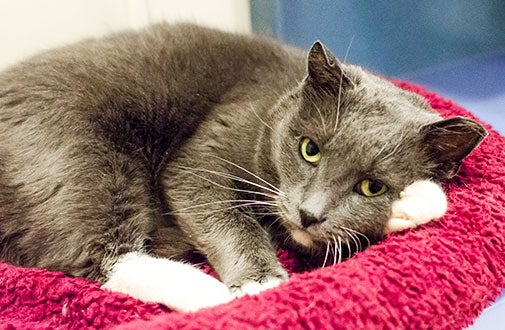
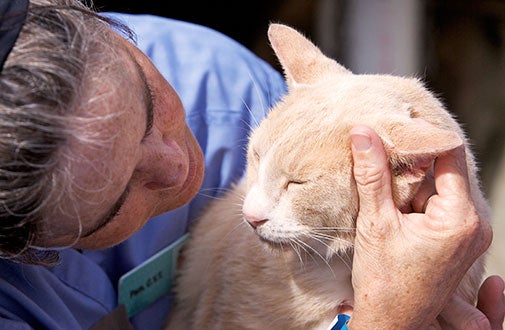
Your cat’s ears may be able to pick up the sound of a bag of treats being opened across the house, but they could still use a little help staying clean. Monitoring your kitty’s ears once per week for wax, debris and infection will help those sensitive sonar detectors stay perky and alert to your every move.
Expand to read more
Outer Ear Check
A healthy feline ear flap, or pinna, has a layer of hair on its outer surface with no bald spots, and its inner surface is clean and light pink. If you see any discharge, redness or swelling, your cat’s ears should be checked by a veterinarian.
Inner Ear Exam
Bring kitty into a quiet room where there are no other pets. Gently fold back each ear and look down into the canal. Healthy inner ears will be pale pink in color, carry no debris or odor and will have minimal if no earwax. If you find that your cat’s ears are caked with wax or you detect an odor, please bring her in for a veterinary exam.
Ear Cleaning 101
- Place a little bit of liquid ear cleaner (ask your vet for a recommendation) onto a clean cotton ball or piece of gauze.
- Fold kitty’s ear back gently and wipe away any debris or earwax that you can see on the underside of her ear.
- Lift away the dirt and wax rather than rubbing it into the ear. And do not attempt to clean the canal—probing inside of your cat’s ear can cause trauma or infection.
Signs of Ear Problems
Watch for the following signs that may indicate your cat’s ears should be checked by a veterinarian.
- Persistent scratching and pawing of the ear area
- Sensitivity to touch
- Head tilting or shaking
- Loss of balance and disorientation
- Redness or swelling of the ear flap or canal
- Unpleasant odor
- Black or yellowish discharge
- Accumulation of dark brown wax
- Hearing loss
- Bleeding
Know Your Ear Disorders
- Ear mites are common parasites that are highly contagious among pets. Telltale signs include excessive itching of the ears and debris that resembles coffee grounds.
- Ear infections are usually caused by bacteria, yeast or foreign debris caught in the ear canal. Treatment should be sought immediately as ear infections can cause considerable discomfort and may indicate allergies, hormonal abnormalities or hereditary disease.
- Blood blisters (hematoma) are the result of blood accumulation in the ear flap. They’re often caused by infection, ear mites, fleas or trapped debris that causes your cat to scratch her ears or shake her head excessively.
Paw and Nail Care
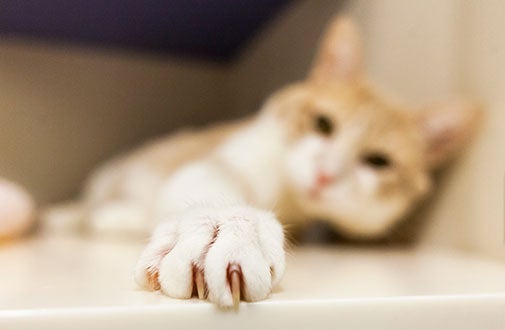
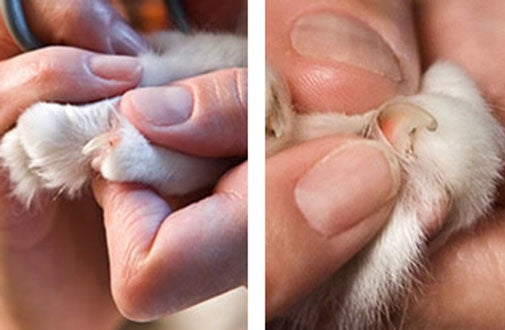
Healthy Paws
Cats need healthy feet to scratch, climb and achieve their famed acrobatic landings. That’s why it’s important to regularly examine and clean your cat’s paws and make sure they’re wound-free.
Expand to read more
- Your cat’s feet should always be kept clean. Aside from causing pain, unhealthy substances that stick to her feet may end up on her tongue during grooming. Once each day, give your cat’s paws a gentle wipe with a damp cloth, checking between her toes and around the paw pads. Keeping your floors and other surfaces free of debris and household chemicals will go a long way to help keep your cat’s feet clean.
- Cats are natural explorers who sometimes get into foreign places. Check your cat’s paws regularly for any cuts, sores, splinters or swellings. Remove splinters or debris gently with tweezers and clean any small cuts. If you notice any blood, pus or an unusual odor, please take your cat to the vet to check for infection.
- Long-haired kitties may have hair sprouting in between their toes. If this irritates your cat (you’ll know if she licks at the hair obsessively), trim them gently with a small pair of rounded scissors.
- Be wary of your kitty’s sensitive paw pads. In hot and cold weather, moisturize them with a vet-recommended product and try to avoid letting your cat’s feet touch freezing patios, hot sidewalks or other uncomfortable surfaces.
- If you notice your cat obsessively cleaning her paws, limping or favoring one leg, please investigate—she might require veterinary attention.
Nail Care
Does your kitty disappear when the clippers come out? Do you have to wrap her in a towel to give her a manicure? Follow these steps to help your cat relax while you trim.
Expand to read more
- Choose a chair in a quiet room where you can comfortably sit your cat on your lap. Get her when she’s relaxed and even sleepy, such as in her groggy, after-meal state. Take care that she isn’t able to spy any birds, wild animals or action outside nearby windows—and make sure no other pets are around.
- Gently take one of your cat’s paws between your fingers and massage for no longer than three seconds. If your cat pulls her paw away, don’t squeeze or pinch, just follow her gesture, keeping in gentle contact. When she’s still again, give her pad a little press so that the nail extends out, then release her paw and immediately give her a treat. Do this every other day on a different toe until you’ve gotten to know all ten.
- Your cat should be at ease with the sound of the clippers before you attempt to trim her nails. Sit her on your lap, put a piece of uncooked spaghetti into the clippers and hold them near your cat. (If she sniffs the clippers, set a treat on top of them for her to eat.) Next, while massaging one of your cat’s toes, gently press her toe pad. When the nail extends, clip the spaghetti with the clippers while still holding your cat’s paw gently. Now release her toe and quickly give her a treat.
- The pink part of a cat’s nail, called the quick, is where the nerves and blood vessels are. Do NOT cut this sensitive area. Snip only the white part of the claw. It’s better to be cautious and cut less of the nail rather than risk cutting this area. If you do accidentally cut the quick, any bleeding can be stopped with a styptic powder or stick. It’s a good idea to keep it nearby while you trim.
- With your cat in your lap facing away from you, take one of her toes in your hand, massage and press the pad until the nail extends. Now trim only the sharp tip of one nail, release your cat’s toe and quickly give her a treat. If your cat didn’t notice, clip another nail, but don’t trim more than two claws in one sitting until your cat is comfortable. Then, reward her with a special treat.
- A nail-trimming every ten days to two weeks is recommended. If your cat refuses to let you clip her claws, ask your vet or a groomer for help.
- If your cat resists, don’t raise your voice or punish her. Never attempt a clipping when your cat is agitated or you’re upset. And don’t rush—you may cut into the quick.
- Don’t try to trim all of your cat’s claws at one time.
- Do NOT declaw your cat. This surgery involves amputating the end of a cat’s toes and is highly discouraged by the ASPCA. Instead, trim regularly, provide your cat with appropriate scratching posts and ask your veterinarian about soft plastic covers for your cat’s claws.
Dental Care
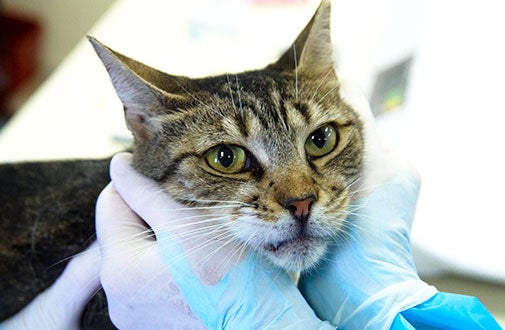
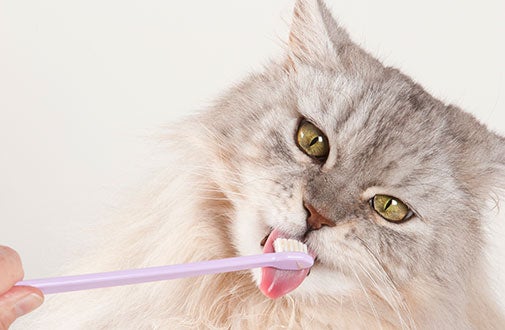
Your cat needs clean, sharp teeth and healthy gums. Damage to the tongue, teeth, palate and gums can lead to many health risks for felines, but these can be prevented with regular home check-ups and good old-fashioned brushings.
Expand to read more
- If your kitty’s mouth has an abnormally strong odor, he may have digestive problems or a gum condition such as gingivitis, and should be examined by a vet.
- With your cat facing you, gently push back his lips and take a look. The gums should be firm and pink, not white or red, and should show no signs of swelling. The teeth should be clean and free of any brownish tartar, and none should be loose or broken.
- Watch for any of the following signs that could indicate problems in your cat’s mouth:
- Dark red line along the gums
- Red and swollen gums
- Ulcers on gums or tongue
- Loose teeth
- Pus
- Difficulty chewing food
- Excessive drooling
- Excessive pawing at the mouth area
- At any sign of gum inflammation, you should take your cat in for a veterinary exam. If left untreated, gum disease can develop, possibly leading to tooth loss or inability to eat Inflammation may also point to an internal problem like kidney disease or Feline Immunodeficiency Virus.
- Bacteria and plaque-forming foods can cause a buildup on a cat’s teeth. This can harden into tartar, possibly causing gingivitis, receding gums and tooth loss.
- All you’ll need to brush your cat’s teeth are cotton swabs and a small toothbrush and tube of toothpaste formulated for felines. You can also use salt and water. Ask your vet to suggest the brushing supplies that he trusts, and be sure never to use toothpaste designed for people—the ingredients can be unhealthy for your cat.
Brush your cat’s teeth at home by following these simple steps:
- First get your cat used to the idea of having her teeth brushed. Start by gently massaging her gums with your fingers or touching a cotton swab to them.
- After a few sessions, put a little bit of cat-formulated toothpaste on her lips to get her used to the taste.
- Introduce a toothbrush designed especially for cats—it will be smaller than human toothbrushes and have softer bristles. Toothbrushes that you can wear over your finger are also available and allow you to give a nice massage to your cat’s gums.
- Apply the toothpaste to her teeth for a gentle brushing.
Chew toys can satisfy your cat’s natural desire to chomp, while making her teeth strong. Gnawing on a chew toy can also help floss your cat’s teeth, massage her gums and scrape away soft tartar.
If your cat suffers from any of the symptoms mentioned below, please see the vet right away:
- Gingivitis: This inflammation of the gums is mainly seen in older cats. It may start as a dark red line bordering on the teeth. If left untreated, gums may become sore and ulceration may occur. This may be a sign of FIV or other infection.
- Periodontitis: If gingivitis invades the tooth socket, the tooth may become loose and an abscess may form.
- Stomatitis: This inflammation of the mouth lining may result from a foreign body in the mouth, a viral disease or dental problems. The cat will have difficulty eating and the inside of the mouth will appear red.
- Rodent Ulcer: A slowly enlarging sore or swelling on the upper lip.
- Salivary Cyst: If salivary glands or ducts that carry saliva to the mouth become blocked, a cyst may form under the tongue.
- Mouth Ulcers: Ulcers on a cat’s tongue and gums are sometimes caused by feline respiratory or kidney disease.
Eye Care
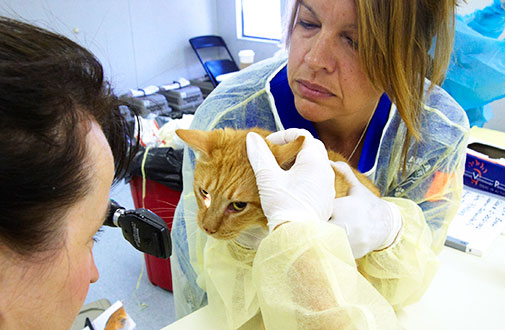

A good home eye exam just before grooming can clue you into any tearing, crust, cloudiness or inflammation that may indicate a health problem. Here are few simple tips to keep your kitty’s eyes bright and healthy.
Expand to read more
- Face your cat in a brightly lit area and look her in the eyes. They should be clear and bright, and the area around the eyeball should be white. Her pupils should be equal in size.
- Roll down your kitty’s eyelid gently with your thumb and take a look at the lid’s lining. It should be pink, not red or white.
- Wipe away any crusty gunk from your cat’s eyes with a damp cotton ball. Always wipe away from the corner of the eye, and use a fresh cotton ball for each eye. Snip away any long hairs that could be blocking her vision or poking her eyes. Try not to use eye washes or eye drops unless they’ve been prescribed by your vet.
How can you tell if there is something wrong with one or both of your cat’s eyes? Look out for the following:
- Discharge
- Watering
- Red or white eyelid linings
- Crusty gunk in the corners of the eye
- Tear-stained fur
- Closed eye(s)
- Cloudiness or change in eye color
- Visible third eyelid
Certain body language will also alert you to possible eye distress. If your cat is constantly squinting or pawing at her eye area, give her eyes a good inspection. If you find any of the above symptoms, you should immediately call your vet.
The following eye-related disorders are commonly seen in cats:
- Conjunctivitis: One or both of your cat’s eyes will look red and swollen, and there may be discharge.
- Third eyelid protrusion: If the third eyelid becomes visible or crosses your cat’s eye, he may have a wound or may be suffering from diarrhea, worms or a virus.
- Keratitis: If your cat’s cornea becomes inflamed, the eye will look cloudy and watery.
- Cataracts: This opacity on the eye is often seen in elderly and diabetic cats.
- Glaucoma: The cornea becomes cloudy and the eye enlarges due to an increased pressure in the eyeball.
- Bulging eye: Bulging can occur because of accident or trauma or an eye tumor.
- Retinal disease: Partial or total vision loss can happen when light-sensitive cells at the back of the eye degenerate.
- Watery eyes: The fur around your cat’s eyes may be stained with tears because of blocked tear ducts or an overproduction of tears.
Many feline eye disorders can be treated with vet-prescribed drops or ointments—your vet will show you how to apply eye and ear drops at home.
The best way to prevent eye conditions is to make sure your cat gets all her vaccinations and has thorough check-ups. Please examine her eyes regularly and consult a vet if you find any abnormalities. Eye conditions that are left untreated can lead to impaired sight or even blindness.
